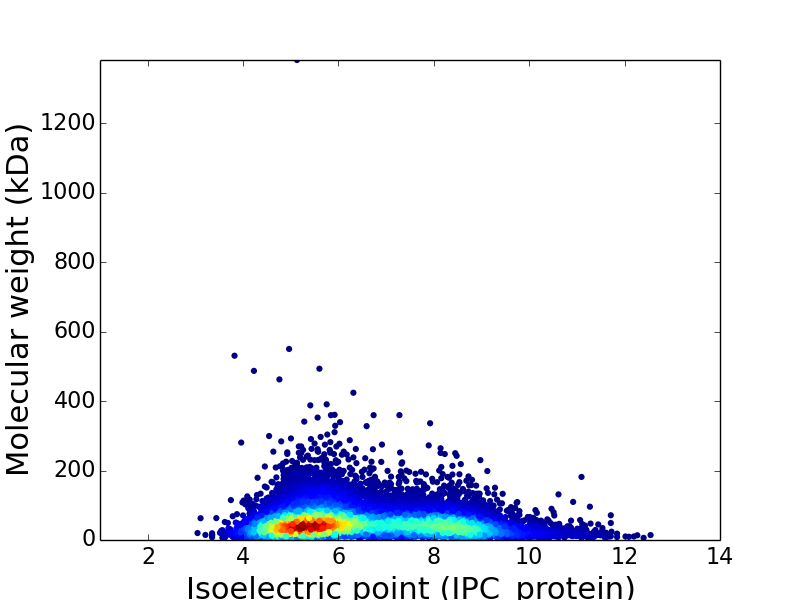
Arthrobotrys oligospora (strain ATCC 24927 / CBS 115.81 / DSM 1491) (Nematode-trapping fungus) (Didymozoophaga oligospora)
Taxonomy: cellular organisms; Eukaryota; Opisthokonta; Fungi; Dikarya; Ascomycota; saccharomyceta; Pezizomycotina; Orbiliomycetes; Orbiliales; Orbiliaceae; Orbilia; mitosporic Orbilia auricolor; Arthrobotrys oligospora
Average proteome isoelectric point is 6.53
Get precalculated fractions of proteins

Virtual 2D-PAGE plot for 11,478 proteins (isoelectric point calculated using IPC_method)
Get csv file with sequences according given criteria:
* You can choose from 18 different methods for calculating isoelectric point
Protein with the lowest isoelectric point:
>tr|G1XDE7|G1XDE7_ARTOA Uncharacterized protein
MEKVVQALTVLTEVASTALYVVVSHEVVVVVVVDVIISYAGGKDDEDEEEDDELEDDEEELEEDDDESEDDEEESEEDDDDDDDDDDESEDDDDDDDDEDDDEEEDDNESEEEDDDDESEDDGDDDGDDDDEEEEGEEEDGKDDEEYGEIDEFNDEISKDEGREEEVREEKPKLD
MEKVVQALTVLTEVASTALYVVVSHEVVVVVVVDVIISYAGGKDDEDEEEDDELEDDEEELEEDDDESEDDEEESEEDDDDDDDDDDESEDDDDDDDDEDDDEEEDDNESEEEDDDDESEDDGDDDGDDDDEEEEGEEEDGKDDEEYGEIDEFNDEISKDEGREEEVREEKPKLD
Molecular weight: 20.03 kDa
Isoelectric point according different methods:
Isoelectric point according different methods:
Protein with the highest isoelectric point:
>tr|G1X9B7|G1X9B7_ARTOA Uncharacterized protein
MTILTLLRRPAISCLRSTASSSSRRTFTSLLRTPTTIITLQTRPTLHSSPTSLIPQTTSSTSQTTSTSLLLPLQGLTQTRGHRRKTYNPSHIVRKRRFGFLARLRSKTGKNILKRRKAKGRKMLTH
MTILTLLRRPAISCLRSTASSSSRRTFTSLLRTPTTIITLQTRPTLHSSPTSLIPQTTSSTSQTTSTSLLLPLQGLTQTRGHRRKTYNPSHIVRKRRFGFLARLRSKTGKNILKRRKAKGRKMLTH
Molecular weight: 14.23 kDa
Isoelectric point according different methods:
Isoelectric point according different methods:
General Statistics
Number of major isoforms |
Number of additional isoforms |
Number of all proteins |
Number of amino acids |
Min. Seq. Length |
Max. Seq. Length |
Avg. Seq. Length |
Avg. Mol. Weight |
|---|---|---|---|---|---|---|---|
0 |
5,722,854 |
49 |
12,515 |
498.6 |
55.3 kDa |
Amino acid frequency
Ala |
Cys |
Asp |
Glu |
Phe |
Gly |
His |
Ile |
Lys |
Leu |
Met |
Asn |
Gln |
Pro |
Arg |
Ser |
Thr |
Val |
Trp |
Tyr |
|---|---|---|---|---|---|---|---|---|---|---|---|---|---|---|---|---|---|---|---|
7.54 |
1.21 |
5.65 |
6.63 |
3.72 |
6.84 |
2.18 |
5.42 |
5.54 |
8.53 |
2.02 |
4.09 |
3.82 |
6.18 |
5.77 |
8.35 |
6.34 |
5.88 |
1.36 |
2.92 |
For dipeptide frequency statistics click here
Proteome-pI is available under Creative Commons Attribution-NoDerivs license, for more details see here
| Reference: Kozlowski LP. Proteome-pI: proteome isoelectric point database. Nucleic Acids Res. 2016. doi: 10.1093/nar/gkw978 |
Contact: Lukasz P. Kozlowski |

